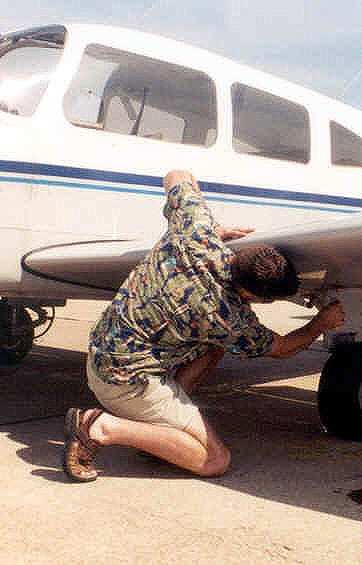Aero-Tips!
A good pilot is always learning -- how many times have you
heard this old standard throughout your flying career? There is no
truer statement in all of flying (well, with the possible exception
of "there are no old, bold pilots.")

Aero-News has called upon the expertise of Thomas P. Turner,
master CFI and all-around-good-guy, to bring our readers -- and us
-- daily tips to improve our skills as aviators. Some of them, you
may have heard before... but for each of us, there will also be
something we might never have considered before, or something that
didn't "stick" the way it should have the first time we memorized
it for the practical test.
Look for our daily Aero-Tips segments, coming each day to
you through the Aero-News Network.
Aero-Tips 07.21.06
It was a warm summer evening, perfect for flying. My student,
who had just purchased a well-equipped, high-performance aircraft,
was chomping to begin his required Complex and High Performance logbook
endorsements and the 15 hours of dual instruction required under
his insurance policy. I'd agreed to let his CFII sit in because,
although I am going to conduct most of my client's checkout, he may
fly some with the "double-I" and I wanted to make sure the
instructor knew some of the trivia that makes the difference
between a safe flight and trouble.

Trivia indeed came into play. After briefing my student and his
instructor for the first flight we began a preflight inspection,
looking closely at the type-specific aircraft items that have
historically been problematic or led to mishap. About half an hour
into an expanded "teaching" preflight we noticed a small-diameter
spring, about three inches long and normally hidden partly by a
canvas cover in the main wheel well, was broken. A small portion of
the thin spring was dangling from the uplock arm. "This is a no-go
item," I pronounced reluctantly. For as I explained, the small
spring has a vital function. If it doesn't pull part of the uplock
out of the way when the gear is in transit, the landing gear will
go up on retraction-but it might not come back down.
Handling rejection
Everything in our attitudes told us we were going to fly. The
airplane is beautiful, the skies were clear and warm, and my
200-hour pilot, his time-building instructor and I had spent half
an hour briefing for a fun introduction to the airplane before
another 30 minutes preflighting the otherwise spectacular airplane.
It would have been very easy to miss the spring (in fact, I dug
around under the canvas cover for some time looking for it, hoping
it was attached, even though I should normally be able to see part
of it uncovered) and launch... but with the very real risk of
jamming the landing gear up in the wells.
Further, when we looked, the spring was broken in the other main
gear well also. Somebody had actually stretched the remaining part
of that spring and wrapped it around another cable, looking like a
safety wire. Now we had symmetry -- no spring on either uplock. A
peculiarity of human nature is that "symmetry implies
correctness"... if it's wrong on both sides we try to convince
ourselves both couldn't be broken, so it must be right.
Instead, fighting our urges, we handled the rejected preflight
and turned the lesson into a long cockpit checkout, a valuable use
of our time. My client will have the springs fixed while I'm at
Oshkosh and we'll start again when I get back.
Aero-tip of the day: Don't submit to your
desire to fly when you find something wrong in a preflight
inspection. The short delay you experience now is nothing compared
to the danger and down-time that might result from rationalizing
away a critical preflight squawk.
 ANN's Daily Aero-Linx (04.16.24)
ANN's Daily Aero-Linx (04.16.24) Aero-News: Quote of the Day (04.16.24)
Aero-News: Quote of the Day (04.16.24) Airborne 04.10.24: SnF24!, A50 Heritage Reveal, HeliCycle!, Montaer MC-01
Airborne 04.10.24: SnF24!, A50 Heritage Reveal, HeliCycle!, Montaer MC-01 Airborne 04.12.24: SnF24!, G100UL Is Here, Holy Micro, Plane Tags
Airborne 04.12.24: SnF24!, G100UL Is Here, Holy Micro, Plane Tags Airborne-Flight Training 04.17.24: Feds Need Controllers, Spirit Delay, Redbird
Airborne-Flight Training 04.17.24: Feds Need Controllers, Spirit Delay, Redbird




